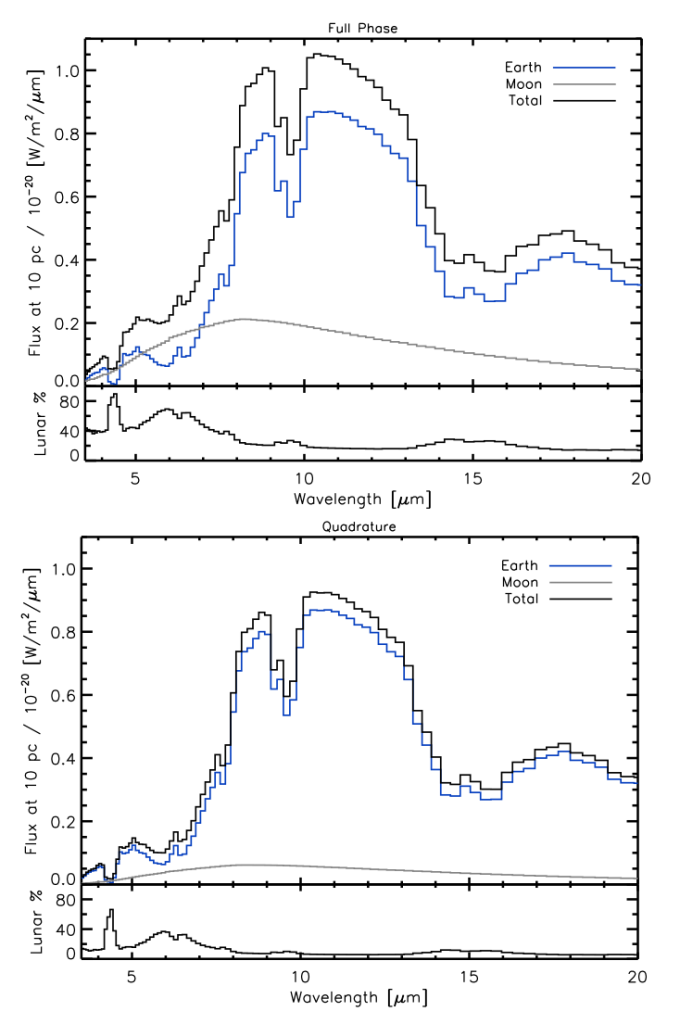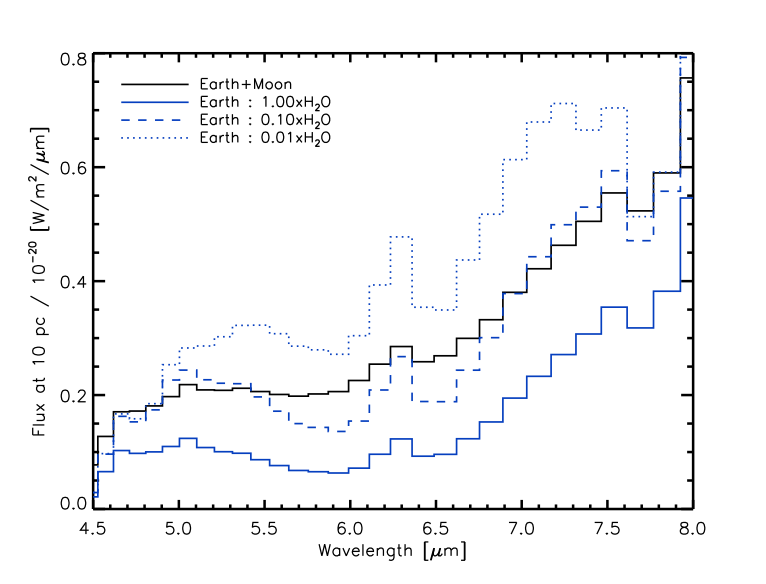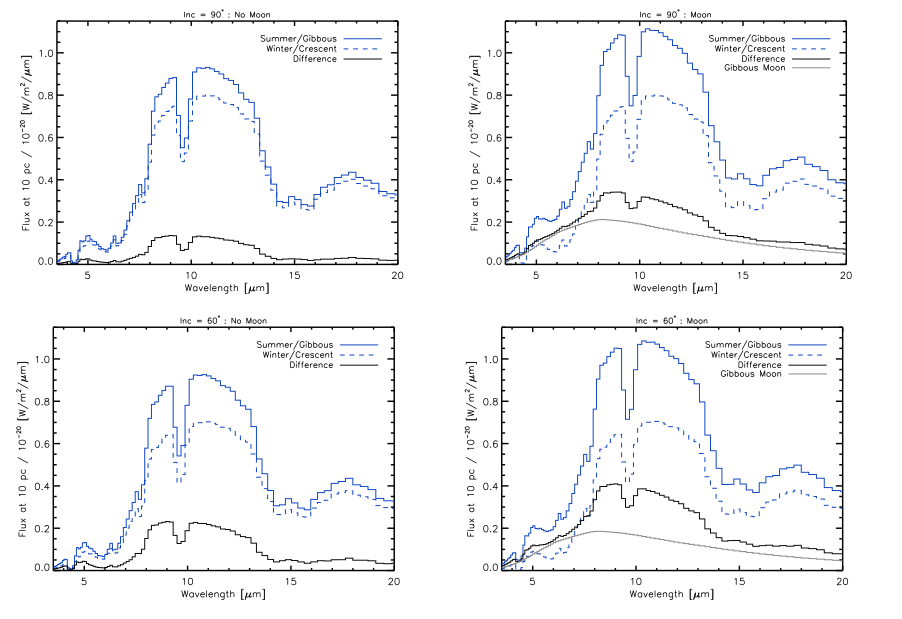• Paper title: Modeling the Infrared Spectrum of the Earth-Moon System: Implications for the Detection and Characterization of Earthlike Extrasolar Planets and their Moonlike Companions (arXiv:1110.3744v1)
• Authors: Tyler D. Robinson
• First Author’s Affiliation: University of Washington
Introduction
The holy grail of exoplanet scientists is the detection and characterization of a true Earth-analog, an “Earth-twin” orbiting another star. A number of great studies have been done towards this goal; see for example the EPOXI mission, which turned the sensors on Deep Impact back towards Earth to see what we could learn about its atmosphere from remote observation alone. Yet many of these studies consider the Earth in isolation. They ignore the fact that we have a very significant companion in the form of the Moon. Given how close the Earth and Moon orbit, it is unlikely that any exoplanet characterization mission we can envision will be able to resolve an Earth-Moon system analog (the Earth-Moon separation would be 5 milliarcseconds at just 5 parsecs). Therefore, any spectra we take of a terrestrial planet would likely include flux from unseen companions. Recent planet formation modelling suggests that impacts of the kind that formed the Moon may be common. What would be the effect of a lunar companion on measured atmospheric spectra, and how might we ascertain the existence of such a companion? This article explored these questions.
Method
This paper builds on previous work that looked for the effect of a lunar body on an Earth-analog in a bolometric (i.e. total luminosity) sense, which found that the orbiting body needed to be Mars-sized in order to be detectable through broadband photometry. In contrast, this work considers the effect of an unseen satellite by looking at the effect of a lunar body on the composite spectrum of an Earth-Moon system.
The Earth model was based on the NAI VPL’s 3-D spectral Earth model, a well-validated model that generates spectrally and temporally resolved synthetic observations of the planet disk. This model was seeded with the most recent satellite data for Earth. The Moon model was built around radiative thermal equilibrium: the amount of energy being radiated by the Moon had to equal the amount of energy intercepted by it. Reflected light was ignored, a simplification validated by the EPOXI analysis. Consequently, the Moon’s spectrum took the form of a blackbody curve. The resultant spectra were studied as a function of system inclination, planetary season, and moon phase.
Results
Because the Moon lacks an atmosphere to redistribute heat, a subsolar “hot-spot” at 400 K developed, leading to a significant contribution of IR flux around 8 microns. Depending on the phase, the Moon could contribute even more flux than the Earth near these wavelengths!

Figure 1: Synthetic spectrum for Moon at full phase relative to observer (top) and half phase (bottom). Note that at full phase, the lunar spectrum swamps the terrestrial output around 6 microns. The lunar contribution is reduced at less-illuminated phases, as we’d expect.
This has a significant impact on characterization efforts near those wavelengths. At full phase, lunar flux could comprise as much as 80% of the total signal in the 6.3 micron water band, and 90% of the signal in the 4.3 micron CO2 band. Even measured at quadrature (half-phase), the total signature is diluted by 40% and 60%, respectively, due to lunar flux.
In the case of the water band, since we would measure a feature that is partially “filled in” due to additional lunar contribution, this would lead us to characterize the planet as much drier than is actually the case. The additional lunar flux would also lead us to overestimate the planetary temperature, which for Earth analogs are derived from flux levels in relatively absorption-free parts of the spectrum, such as the 10-15 micron region between atmospheric bands.

Figure 2: Synthetic spectra spanning the 6.3 micron H2O feature showing the joint Earth+Moon spectrum and comparing to Earth-only models at different water depletion levels. It is hard to differentiate between a true Earth-analog with a Moon and a water-depleted Earth.
Clearly the presence of the Moon has a significant effect on the composite spectrum. Is there some way we could detect if a Moon were there, and figure out what corrections we should apply to separate out the planetary and lunar spectra? The author argues there is. He suggests taking spectra at two opposing seasons of the Earth-analog’s orbit and then examining the difference between these two spectra. If there is no moon, the difference should be small; if a moon is present, there should be significant variability, particularly in features like the 6.3-micron water band and 4.3 micron CO2 band. In fact, this technique could be used with any bands near the blackbody peak of the Moon, so long as the planet was not highly seasonally variable in those bands.

Figure 3: Difference of spectra of a system at different inclinations, with and without a moon. The difference is higher for systems with moons in them, and also for systems closer to edge-on.
It should be noted that this means that lunar phase variations could swamp or strengthen seasonal variations. Therefore until the presence of a moon is demonstrated or ruled out, a precise characterization of the planet’s seasonal variability is not possible.
Conclusions
The presence of an unseen Moon-analog could have a significant impact on the measured spectrum of an Earth-analog. In the near-IR, lunar flux could be dominant at certain wavelengths, potentially masking detections of molecules like CO2 and H20 on the planet, and lunar phase variations could swamp seasonal planetary variations. However, there is hope: differencing the spectra at different seasons and looking at the resulting variability in planetary absorption bands holds the promise of being able to both detect the existence of a lunar companion, and correct for these effects in order to properly characterize the planet itself. Applying these techniques to exoplanet studies could bring us one step closer to detecting and characterizing the first true Earth-analog.

Trackbacks/Pingbacks